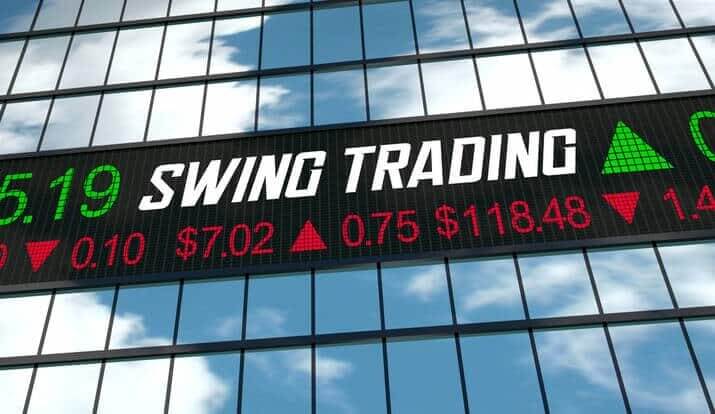
Best Books on Swing Trading: Your Ultimate Reading List
Swing trading is a widely favored approach for individuals looking to supplement their income through trading. This technique involves holding a tradable asset for a duration of one to five days, presenting a convenient yet riskier alternative to scalping and day trading.
Key takeaways
- Swing trading is holding assets for several days to capitalize on expected directional moves in their prices.
- Swing trading suits experienced traders due to its need for market analysis, risk management, and understanding of price patterns.
- What’s interesting is that swing trading offers higher potential profits, flexibility in time commitment, and opportunities to utilize both technical and fundamental analysis effectively.
Developing proficiency in swing trading requires more than just casual learning; it necessitates crafting an effective trading strategy, understanding the optimal duration for maintaining positions, identifying the most suitable days for opening and closing trades, and choosing the right assets for swing trading pursuits.
It’s crucial to have access to quality resources when it comes to wing trading. This guide aims to recommend the best swing trading books, essential for anyone starting in this field.
What exactly is swing trading?
Swing trading is a method where traders aim to capture gains by holding positions from one to five days, though some strategies may extend to several weeks. This medium-term trading approach sits between the short-term nature of day trading and the longer-term strategy of position trading.
In most cases, swing trading is a trading position that lasts more than one trading session but not longer than a week or two.
Key to swing trading is the pursuit of significant price movements, leveraging both technical and fundamental analysis. Crucial in this process is effective risk management, especially in maintaining a favourable risk-reward ratio.
Advantages and disadvantages of swing trading

Let’s start with the advantages of swing trading.
Flexibility: Swing trading can be a part-time endeavor, not requiring constant monitoring like other trading strategies.
Potential for higher returns: When executed well, swing trading can yield greater returns compared to scalp and day trading.
Dynamic and engaging: This strategy often involves a blend of fundamental analysis and market trends, making it more engaging.
Quick position changes: Swing traders have the ability to quickly enter and exit positions, avoiding prolonged capital lock-in.
It is important to analyze the disadvantages as well.
Exposure to market volatility: Swing trading positions are susceptible to overnight and weekend market fluctuations.
Higher margin requirements: Swing traders face higher margin requirements than day traders.
Overnight interest rates: Some brokers charge overnight interest rates for positions held beyond a trading day.
Understanding these facets of swing trading is vital for anyone looking to delve into this trading style, and the recommended literature serves as an invaluable resource for gaining this knowledge.
Best swing trading books
Let’s focus on the best swing trading books.
“How to Swing Trade” by Andrew Aziz and Brian Pezim is widely considered a leading book on swing trading. It thoroughly educates beginners on the essentials of swing trading, including strategy basics, risk management, various techniques, and practical examples.
This makes it a prime choice for newcomers eager to step into the trading arena with a focus on swing trading.
Another notable book for beginners is “Swing Trading for Beginners” by Jeff McMillan. McMillan outlines seven crucial rules for swing trading success and delves into fundamental preparatory steps for new traders.
The book offers guidance on selecting brokerage accounts, determining starting capital, identifying optimal entry points, following influential traders on social media, and exploring unique swing trading strategies and techniques. It even extends its insights to cryptocurrency and forex trading.
“The Master Swing Trader” by Alan Farley is highly recommended for both novices and intermediate traders.
Farley’s approach includes market analysis through chart reading, pattern recognition, and gauging market sentiment. The book is rich in trading examples and techniques for capitalizing on short-term trading opportunities, demonstrated through over 200 charts within its 443 pages.
Steve Burns, author of seventeen trading-focused books, adds to the list with his works “The Ultimate Guide on Technical Analysis” and “The Ultimate Guide to Candlestick Chart Patterns.”
“The Ultimate Guide to Swing Trading” by Steve Burns and Holly Burns stands out as a comprehensive resource covering all swing trading facets.
Burns shares his own trading strategies and insights, focusing on essential elements like setting an appropriate risk-reward ratio for swing trading, developing a trading plan, and understanding trading psychology. Spanning 124 pages, this book serves as a thorough guide for traders at all levels.
Books by Kathy Lien and Laurentiu Damir

There are many books about swing trading. However, books by Kathy Lien and Laurentiu Damir deserve to be mentioned among the best swing trading books.
“Day Trading and Swing Trading the Currency Market: Technical and Fundamental Strategies to Profit from Market Moves” by Kathy Lien is an essential read for those interested in forex trading.
This book adeptly covers both day trading and swing trading in the forex market, highlighting the importance of understanding and potentially integrating these two strategies.
Lien provides various effective strategies for profiting in the forex market, going beyond basic information to offer clear, illustrative instructions and in-depth explanations of different trading approaches.
It stands out as a comprehensive guide, equipping readers with the necessary knowledge to establish a trading account and grasp market dynamics.
In “In Depth Guide to Price Action Trading: Powerful Swing Trading Strategy for Consistent Profits,” Laurentiu Damir presents a straightforward and practical approach to swing trading.
This book differs from others by focusing on a singular, effective swing trading strategy, emphasizing the importance of a proper risk-reward ratio over complex technical analysis and trading techniques.
Damir also highlights the significance of using chart patterns and Fibonacci levels for determining optimal entry and exit points. Concise and to the point, this guide offers fundamental rules and insights for effectively utilizing swing trading strategies.
Swing Trading: Power Strategies to Cut Risk and Boost Profits
The book, written by Jon D. Markman, is a guide that transforms swing trading into a methodical business approach.
It emphasizes the importance of risk management, showing readers how to reduce risk effectively while maintaining positions from days to weeks.
This book is particularly suitable for those looking to supplement their income through swing trading without the need to constantly monitor the market.
Similarly, “Swing Trading as a Part-Time Job” is another valuable resource for individuals seeking additional income through swing trading alongside their primary job.
Author Brett Brown provides a comprehensive set of guidelines and insights on key aspects of swing trading, including risk management tools, chart patterns, economic news interpretation, and technical analysis indicators.
The book is notable for its straightforward explanation of complex trading concepts, making it accessible to non-professional traders. It simplifies trading terminology, enabling readers to confidently analyze markets and hold positions over several days.
What makes swing trading so important to traders?

Swing trading occupies a significant niche in the financial markets, offering a balanced blend of speed and patience, making it an appealing strategy for many traders. Its importance can be attributed to several key factors:
Flexibility in time commitment: Swing trading is less time-intensive than day trading but more active than long-term investment strategies. This flexibility makes it ideal for individuals who cannot commit to the markets full-time but still wish to actively participate.
Profit potential: By capturing the ‘swings’ or movements in market prices over days or weeks, swing traders can potentially achieve substantial profits. This strategy leverages short-term price momentum, which can be especially profitable in volatile or trending markets.
Risk management: Swing trading allows for more time to analyze and react to market changes compared to day trading. This extended timeframe can lead to more informed decision-making and better risk management, as traders are not under the pressure of closing positions within a single day.
Accessibility to beginners: While swing trading requires knowledge and skill, it is generally more accessible to beginners than more complex trading strategies like day trading or scalping. The slower pace allows new traders to learn and adapt.
Diversification of trading styles: For experienced traders, swing trading offers a way to diversify their trading styles and strategies. It can be combined with other trading approaches, providing a balanced portfolio and mitigating risks associated with any single method.
In summary, swing trading’s importance lies in its flexible time commitment, profit potential, effective risk management, accessibility for beginners, and its holistic approach to market analysis.
Also, we shouldn’t forget about the importance of the best swing trading books. The above-mentioned books have the potential to help traders achieve their goals.




